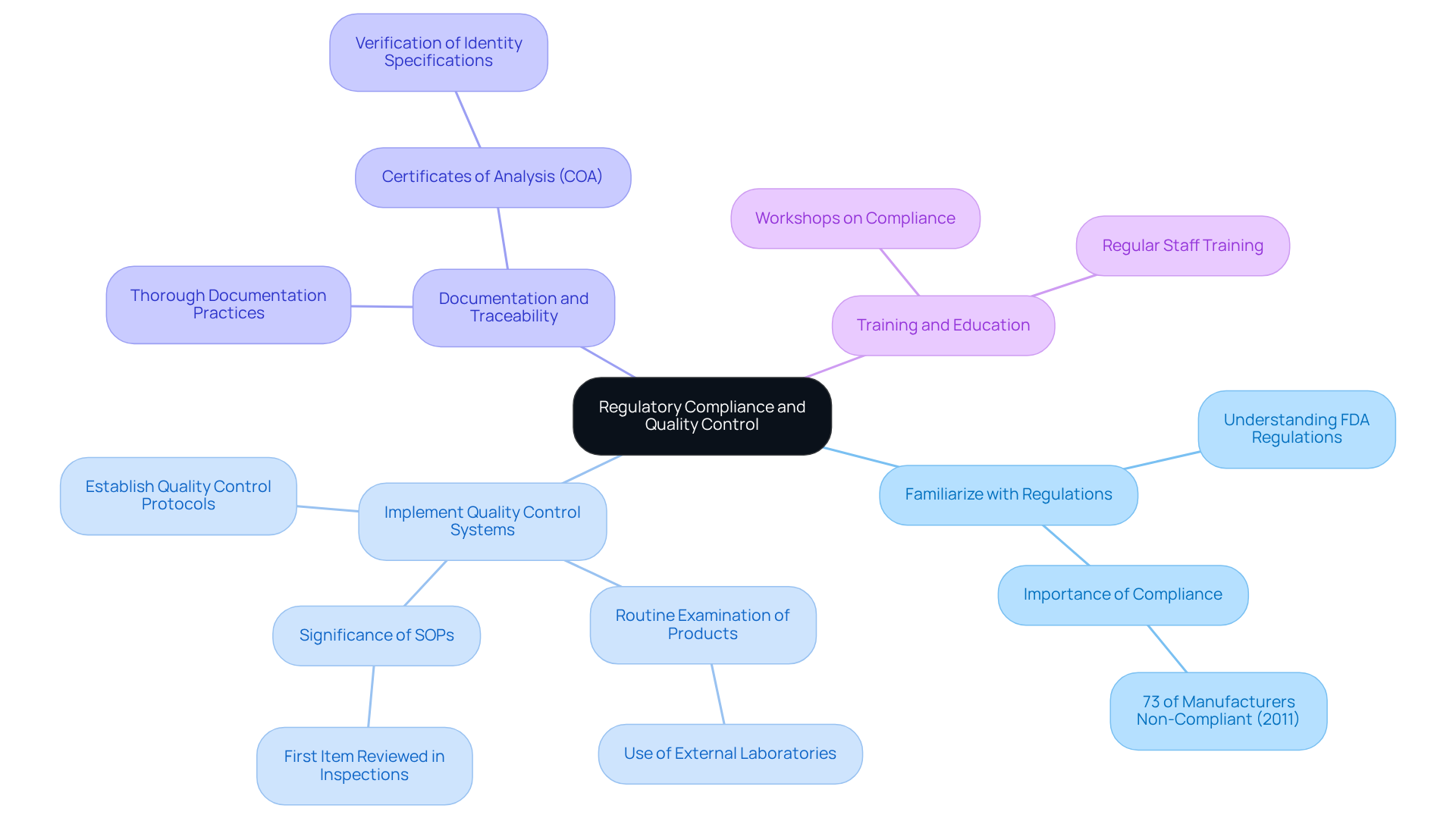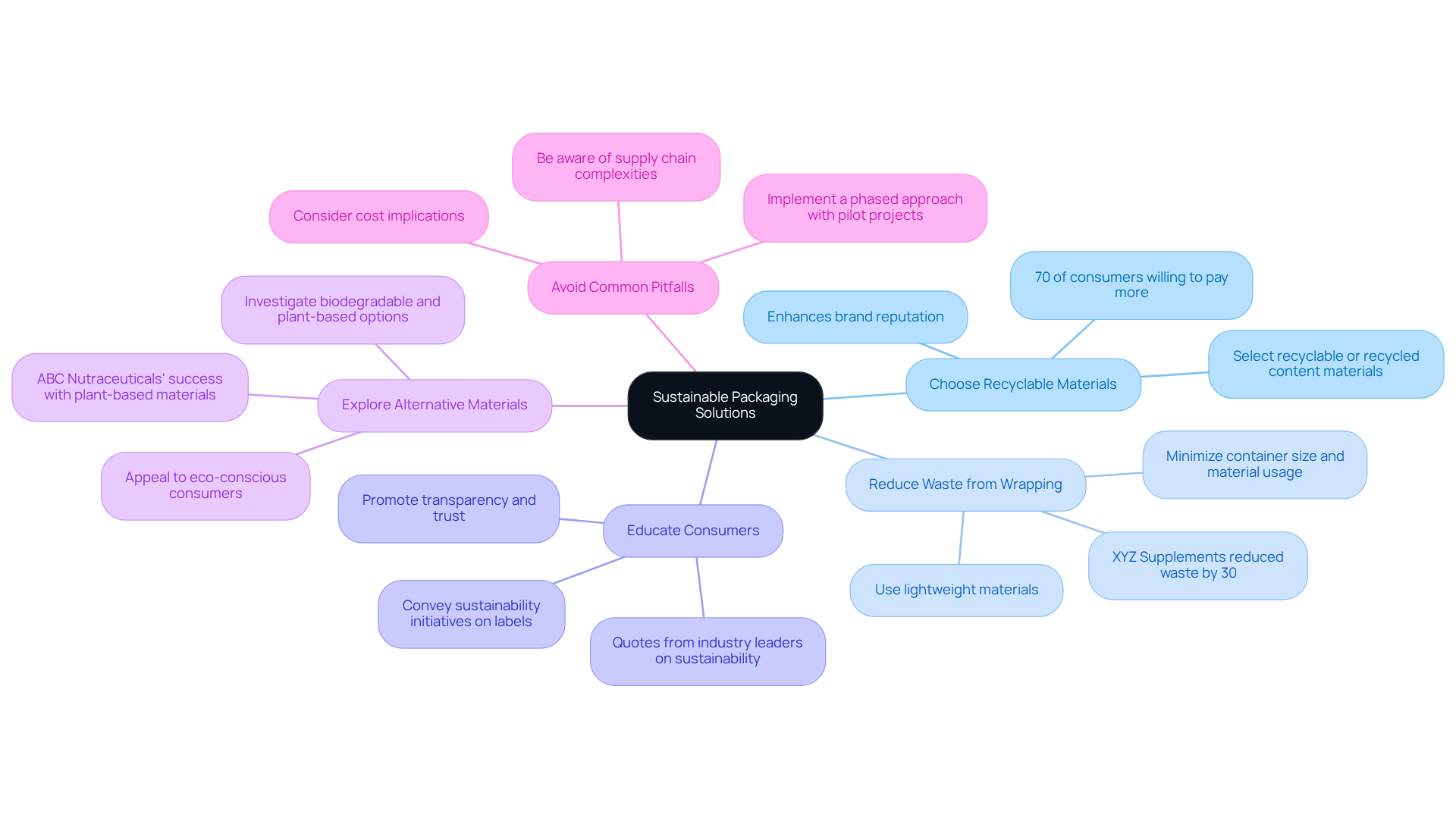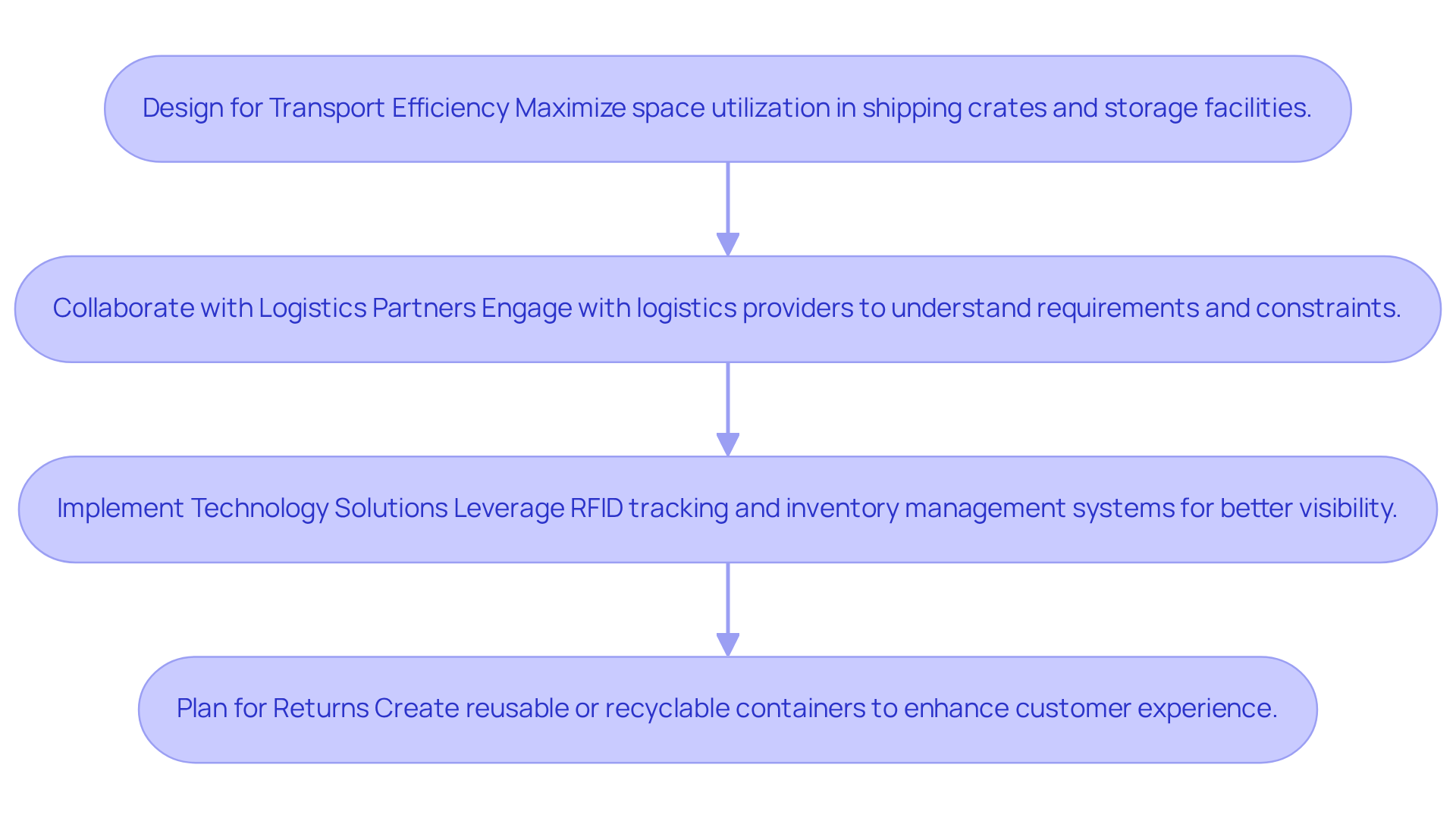Overview
This article delineates four pivotal strategies for attaining success in custom supplement packaging:
- Ensuring regulatory compliance
- Crafting eye-catching designs
- Embracing sustainable practices
- Harmonizing packaging with efficient logistics
Each strategy is bolstered by specific actions and evidence, such as:
- The critical need to adhere to FDA regulations
- The utilization of vibrant colors to enhance consumer appeal
- The implementation of eco-friendly materials
- The optimization of packaging for transportation efficiency
Collectively, these elements serve to bolster brand reputation and enhance operational effectiveness within the nutraceutical market.
Introduction
The landscape of custom supplement packaging is evolving rapidly, driven by increasing consumer expectations and stringent regulatory requirements. Companies venturing into this competitive market stand to gain significantly by adopting strategic approaches to packaging that not only ensure compliance but also enhance brand visibility and consumer trust. However, as the demand for sustainability and functionality rises, brands face the pressing question: how can they effectively navigate these challenges while standing out on the shelves? This article delves into four essential strategies that promise to elevate supplement packaging success in a complex marketplace.
Ensure Regulatory Compliance and Quality Control
To ensure regulatory compliance and uphold high-quality standards in supplement packaging, companies must adopt effective strategies:
-
Familiarize with Regulations: Understanding the specific regulations governing dietary supplements, including labeling requirements and Good Manufacturing Practices (GMP) mandated by the FDA, is crucial. Regularly reviewing updates to these regulations is essential for maintaining compliance and avoiding potential violations. Notably, in 2011, 73% of supplement manufacturers inspected by the FDA failed to adhere to one or more regulations, underscoring the importance of compliance.
-
Implement Quality Control Systems: Establishing robust quality control protocols is vital. This includes routine examination of raw materials and finished products, often employing external laboratories to obtain impartial testing outcomes. Such measures guarantee that items comply with established quality standards, thereby reducing the likelihood of contamination or adulteration. As the Natural Products Association states, "SOPs are usually the first item reviewed in a regulatory inspection," highlighting the significance of standard operating procedures in maintaining compliance.
-
Documentation and traceability are essential, as maintaining thorough documentation throughout the entire process—from sourcing ingredients to custom supplement packaging—is critical. This practice not only ensures traceability and accountability but also proves invaluable during audits or inspections, demonstrating adherence to regulatory standards. Additionally, maintaining Certificates of Analysis (COA) to verify identity specifications is crucial for comprehensive documentation.
-
Training and Education: Regular training for staff on compliance requirements and quality control procedures fosters a culture of quality within the organization. Workshops and certifications related to dietary supplement regulations enhance employees' understanding and commitment to maintaining high standards.
By prioritizing compliance and quality control, companies can significantly mitigate risks associated with regulatory violations and enhance consumer confidence in their products. The FDA's final GMPs emphasize that testing should verify compliance with specifications rather than being the sole focus of quality assurance, highlighting the importance of a comprehensive approach to quality management. Furthermore, the FDA's final GMP regulation for dietary supplements mandates stringent requirements for manufacturers regarding the identity, purity, quality, strength, and composition of dietary ingredients, reinforcing the need for adherence to these regulations.

Incorporate Eye-Catching and Functional Design Features
To create eye-catching and functional supplement packaging, consider the following strategies:
-
Utilize Bold Colors and Graphics: Choose colors and graphics that resonate with your identity and appeal to your target demographic. Research indicates that vibrant colors can enhance shelf visibility, with 70% of purchasing decisions driven by visual elements alone, making them crucial for attracting consumer attention. As the Cpluz Team states, "Today, a well-designed package might be the defining factor that steers a buyer’s decision." Western Packaging specializes in innovative packaging design solutions that enhance your item's shelf appeal and brand recognition.
-
Clear Labeling: Ensure that product information, including ingredients, benefits, and usage instructions, is prominently displayed. Employ legible fonts and sizes to enhance readability, as 76% of consumers consider labels when making healthier choices. Significantly, 63% of customers state that the container is as crucial as the label itself, highlighting the necessity for clarity in design. Western Packaging can assist in creating engaging graphic assets that guarantee a unified and captivating identity.
-
Creative Container Designs: Experiment with unique container shapes that stand out on shelves. For instance, a bottle with a distinctive silhouette can create a memorable impression, reinforcing brand recognition and appeal. In fact, 81% of buyers have purchased a new item because the wrapper attracted their attention, emphasizing the impact of creative design elements. With years of experience, Western Packaging focuses on discovering the best flexible solutions customized to your requirements, including large pouches for protein items and stick packs for nutraceuticals.
-
Functional Features: Incorporate usability-enhancing features, such as resealable pouches or easy-to-open caps. These practical aspects not only enhance the customer experience but also promote repeat purchases, as 52% of clients are more inclined to buy again from companies that emphasize quality presentation. Furthermore, with 82% of shoppers ready to spend extra for sustainable goods, exploring eco-conscious wrapping alternatives can connect your label with contemporary buyer values. Western Packaging offers creative solutions that enhance product appeal and fulfill your unique requirements.
By concentrating on both aesthetics and functionality, brands can create containers that not only attract consumers but also effectively fulfill their practical needs.

Adopt Sustainable and Eco-Friendly Packaging Solutions
To successfully adopt sustainable and eco-friendly packaging solutions, companies should consider the following strategies:
-
Choose Recyclable Materials: Select materials for wrapping that are recyclable or derived from recycled content. This method not only reduces ecological impact but also appeals to individuals who prioritize sustainability, enhancing brand reputation. According to recent studies, over 70% of consumers are willing to spend more for items with sustainable materials, highlighting the increasing demand for eco-friendly alternatives.
-
Reduce Waste from Wrapping: Implement strategies to minimize container size and material usage without compromising product integrity. Using lightweight materials or creating containers that require less material can significantly decrease waste and transportation emissions. Businesses such as XYZ Supplements have effectively decreased their waste from containers by 30% through inventive design methods.
-
Educate Consumers: Clearly convey sustainability initiatives on label information. Include symbols and messages that educate buyers about the environmentally friendly features of the materials, promoting transparency and trust. As Bradley Saveth, President & COO, states, "By prioritizing sustainability, companies can not only reduce their environmental impact but also harness a competitive advantage in a rapidly evolving marketplace."
-
Explore Alternative Materials: Investigate innovative container options, such as biodegradable plastics or plant-based materials, which can further enhance sustainability efforts and appeal to eco-conscious consumers. Brands such as ABC Nutraceuticals have embraced plant-based materials, which has been well-received by their environmentally conscious customer base.
-
Avoid Common Pitfalls: Be aware of common challenges in adopting sustainable materials, such as supply chain complexities and cost considerations. A staged method, beginning with pilot projects, can assist in testing and improving sustainable container solutions prior to complete execution.
By incorporating these sustainable practices into their strategies, companies can not only adhere to regulatory requirements but also align with consumer values, ultimately fostering brand loyalty and enhancing market presence.

Integrate Packaging Design with Efficient Logistics and Distribution
To effectively integrate packaging design with efficient logistics and distribution, companies should consider the following strategies:
-
Design for Transport Efficiency: Create containers that maximize space utilization in shipping crates and storage facilities. For instance, reducing product dimensions by just 3 millimeters can increase container density by 25%, leading to significant savings in transportation costs, as noted by Trillora Packaging Solutions.
-
Collaborate with Logistics Partners: Engage closely with logistics providers to understand their specific requirements and constraints. This collaboration can yield solutions that facilitate smoother transportation and handling, ultimately reducing lead times and improving delivery efficiency. As emphasized by UPS, new wrapping designs can enable more packages inside inbound containers, decreasing overall shipping costs.
-
Implement Technology Solutions: Leverage technology such as RFID tracking and inventory management systems to streamline logistics processes. These tools enhance visibility and control over the supply chain, allowing for proactive planning that minimizes damage during transit. The idea of intelligent containers, which incorporates technology to enhance transport efficiency, aligns well with this strategy.
-
Plan for Returns: Create containers that are easily reusable or recyclable in the event of product returns. This approach not only reduces waste but also enhances the overall customer experience, aligning with growing consumer preferences for sustainable practices.
By aligning custom supplement packaging design with logistics strategies, companies can significantly enhance operational efficiency, reduce costs, and improve customer satisfaction, ultimately leading to a more competitive position in the nutraceutical market.

Conclusion
Success in custom supplement packaging relies on a multifaceted approach that encompasses regulatory compliance, quality control, innovative design, sustainability, and logistical efficiency. By prioritizing these elements, companies can not only meet market demands but also establish a robust foundation for brand loyalty and consumer trust.
This article outlines four key strategies:
- Ensuring regulatory compliance and quality control to mitigate risks.
- Incorporating eye-catching and functional design features that attract consumers.
- Adopting sustainable and eco-friendly packaging solutions to align with modern consumer values.
- Integrating packaging design with efficient logistics and distribution to streamline operations.
Each of these strategies is crucial in enhancing the overall effectiveness of supplement packaging.
The significance of these strategies cannot be overstated. As the landscape of the supplement industry evolves, embracing these practices will enhance product appeal, drive operational efficiencies, and foster a responsible brand image. Companies are encouraged to adopt these insights to remain competitive and relevant in a rapidly changing marketplace, ensuring their packaging not only meets consumer expectations but also contributes positively to the environment and industry standards.
Frequently Asked Questions
What is the importance of understanding regulations in supplement packaging?
Understanding regulations is crucial for ensuring compliance with dietary supplement guidelines, including labeling requirements and Good Manufacturing Practices (GMP) mandated by the FDA. Regularly reviewing updates to these regulations helps avoid potential violations.
What percentage of supplement manufacturers inspected by the FDA failed to comply with regulations in 2011?
In 2011, 73% of supplement manufacturers inspected by the FDA failed to adhere to one or more regulations.
How can companies implement effective quality control systems?
Companies can establish robust quality control protocols that include routine examination of raw materials and finished products, often using external laboratories for impartial testing outcomes. This ensures compliance with quality standards and reduces contamination or adulteration risks.
Why is documentation and traceability important in supplement packaging?
Maintaining thorough documentation throughout the entire process—from sourcing ingredients to packaging—is essential for ensuring traceability and accountability. This practice is invaluable during audits or inspections and demonstrates adherence to regulatory standards.
What role does training and education play in regulatory compliance?
Regular training for staff on compliance requirements and quality control procedures fosters a culture of quality within the organization. Workshops and certifications enhance employees' understanding and commitment to maintaining high standards.
What does the FDA emphasize regarding quality management in dietary supplements?
The FDA emphasizes that testing should verify compliance with specifications rather than being the sole focus of quality assurance. This highlights the importance of a comprehensive approach to quality management.
What are the stringent requirements mandated by the FDA's final GMP regulation for dietary supplements?
The FDA's final GMP regulation mandates stringent requirements for manufacturers regarding the identity, purity, quality, strength, and composition of dietary ingredients, reinforcing the need for adherence to these regulations.




